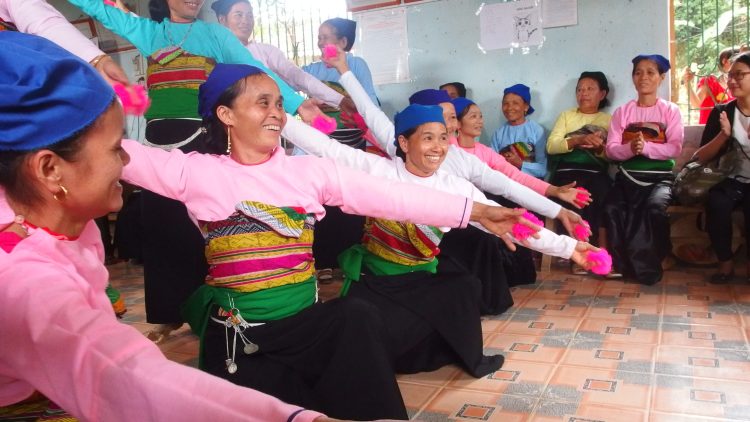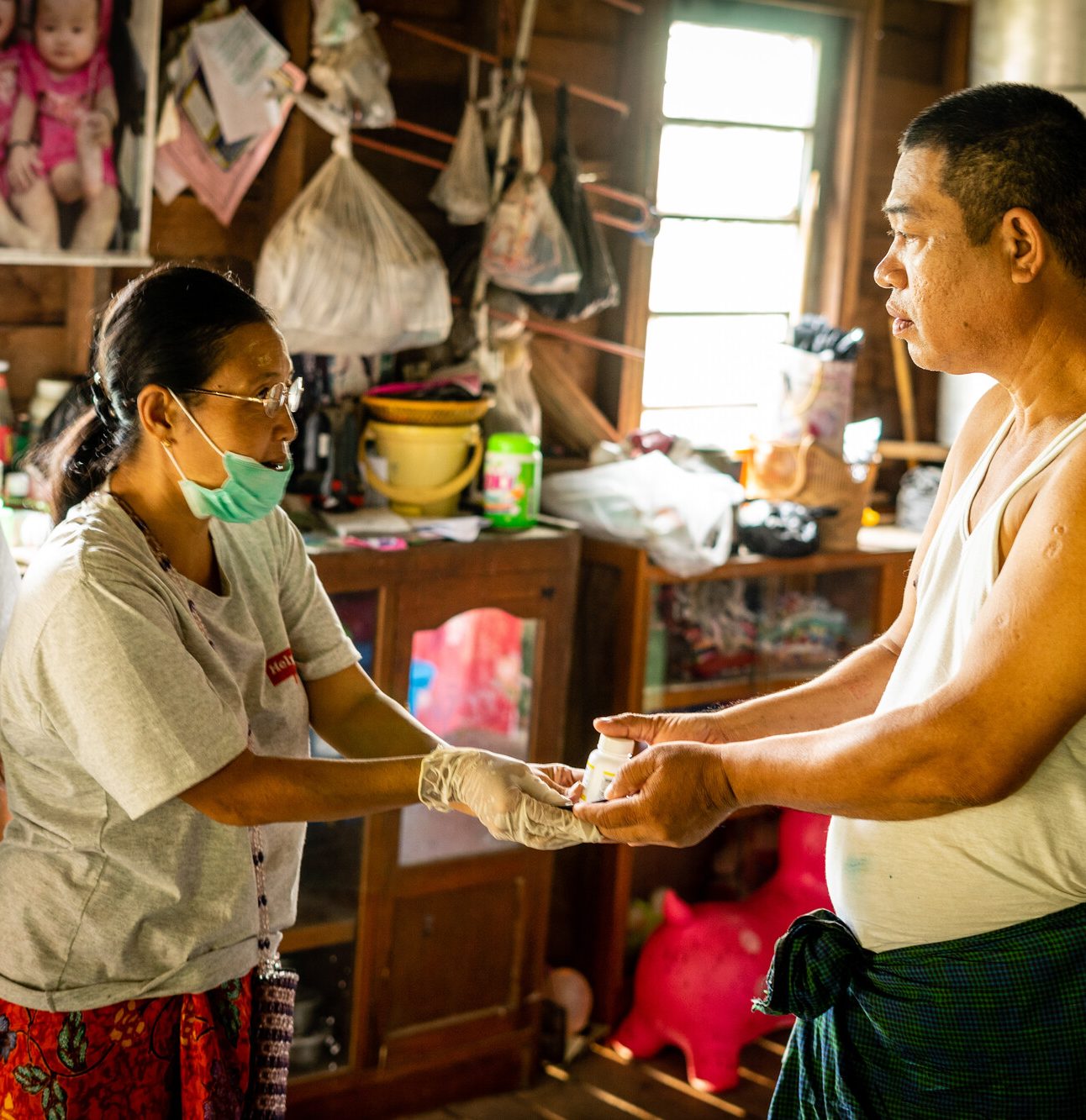The challenge of ageing
Vietnam faces a huge demographic challenge; the older population is set to surge from 14.3 per cent in 2023 to 26.5 per cent in 2050, outpacing economic growth in a country with limited resources to meet these growing needs. With 15 per cent of older people living in poverty and over 50 per cent lacking social pensions, the situation demands urgent attention. Ageing comes with health concerns, often leaving older people isolated, with inadequate support systems.
Employment attitudes compound the issue, favouring younger demographics. The workforce landscape prioritises the youth, leaving many capable individuals without income opportunities beyond a certain age (sometimes as young as 35). Vietnam policy stipulates that women reaching 50 are ‘older’, while men are ‘older’ at 60.
Intergenerational Self-Help Clubs: a response to challenges
ISHCs have emerged as a lifeline for disadvantaged groups, addressing issues ranging from skip-generation households due to the aftermath of Agent Orange. Comprising one-third women, one-third middle-aged individuals (35-55), and one-third older people (60+), these clubs are rooted in empathy and responsiveness.
The clubs originated from ‘empathy clubs’, nationwide clubs set up for families – especially parents – of loved ones with HIV / AIDs, enabling them to support one another and challenge the stigma attached to the disease that was ravaging the country.
They evolved into today’s ISHCs whose members shape the clubs around their needs, operating nationwide at village level. The clubs are voluntary, consisting of between 50-70 people, with a clear structure and a board elected every two years. They support members’ needs and are a mechanism to mobilise local resources including knowledge, training and funding. While there are many other areas that individual clubs might cover, all feature eight core areas:
- Social and cultural: games, cultural performances, exchanging and sharing between clubs and home visits.
- Food and income security: revolving fund schemes (similar to micro-credit and savings projects but run by the community), and vocational training like breeding chickens and planting vegetables
- Healthy ageing: physical exercise and sport, monthly health screening and check-ups, and health and care awareness
- Homecare services provided by volunteers who deliver a care plan that features social care, personal care, living support and medical or health care
- Self-help and community development: monthly self-help and community support, technical support, cash grants and in-kind support such as rice and assistive devices
- Life-long learning: monthly talks, study visits and inter-generational cross learning
- Rights and entitlement: awareness raising, legal support, dialogue with local authorities and monitoring the implementation of policies
- Resource mobilisation: local donations (cash, in kind or labour), monthly membership fees, collective income generating activities such as social enterprises run by members to generate funds for their club, and revolving fund schemes.
Thuy Tran, HelpAge’s country director in Vietnam has worked on ISHCs for almost 20 years ago first as a staff member of HelpAge’s partner Vietnam Women’s Union, and then as part of the HelpAge team from 2011.
Thuy says: “The empathy clubs focused on one issue, but intergenerational clubs are for everyone and address different needs. The reason they can be replicated in the provinces is because they can meet the needs and the wants of the ISHC members, the community and the authorities. It’s in line with the government’s priorities.”
Growth of ISHCs in Vietnam
ISHCs emerged in Vietnam in 2006 as an offshoot of HelpAge’s OPA initiative, initially comprising 60 clubs, ballooning to 980 by 2016. But change really happened when the government recognised the model’s efficacy in tackling the challenges of an aging populace, deeming it a cost-effective solution.
As the driving force behind this transformative initiative, Thuy emphasises HelpAge’s consultative approach: “We supported local partners to set up the model and then brought the government to see the model for themselves. The government supports this because it helps them to address the needs of the most vulnerable.”
Under the National ISHC Replication Project, the Prime Minister greenlit the creation of 2,000 additional ISHCs by 2020 and a further 3,000 by 2025. Currently, 6,335 clubs span all 63 provinces. The ambitious agenda aims for 80 per cent of communes and wards to have at least one ISHC or similar, funded collaboratively by the government, private sector, community, and members.
The HelpAge team prioritises comprehensive training, ensuring that the clubs are self-sufficient within two years, able to operate independently and sustainably. They also train local mentors to provide ongoing support for long-term success.
Thuy stresses HelpAge’s adaptable approach: “We have a model, but it is flexible. Every year we have something new because things have changed. We listen to the people, especially the older people because they are wise.
“We are currently thinking through vocational training for people from 40-45 when they are discharged from factories. Then they can find another form of income and be ready for older age.”
Impact and recognition
The clubs have sparked remarkable transformations among older people, communities, and society at large. They’ve acted as catalysts, nurturing confidence, fostering independence, and fortifying resilience among older generations. Moreover, these clubs have facilitated income generation, encouraged active community involvement, and ignited pursuits of personal interests.
Throughout the COVID-19 pandemic, ISHCs assumed pivotal roles. Identifying critical needs, they provided essential support such as distributing face masks, liquid soap, conducting home care visits, and spearheading fundraising endeavours. They leveraged technology for awareness campaigns, utilising phone calls, community loudspeakers, and online chat rooms. Volunteers manned village checkpoints, recording visitor details and temperatures, while also engaging in various community activities, including clean-up drives and virtual exercise classes.
Recognised for its groundbreaking contributions, the ISHC model earned prestigious accolades. It won the inaugural Healthy Ageing Prize for Asian Innovation in 2020 and garnered commendations from UNDESA for its strides toward achieving Sustainable Development Goals and from WHO for its promotion of healthy ageing. Thuy’s exemplary work with ISHCs earned her recognition in WHO’s Healthy Ageing 50 in 2022. Furthermore, the Wall Street Journal hailed ISHCs as one of the top ten global innovations specifically designed to address challenges posed by ageing populations.
Beyond borders
Vietnam’s ISHC model has garnered attention globally. In 2021, Vietnam’s model was funded by the Government of Japan through the Japan Social Development Fund, administered by the World Bank. Bangladesh, Cambodia, Indonesia and Myanmar are looking to replicate this successful initiative and incorporating it into their national policies. The World Bank, after witnessing the model’s success, extended support to the initiative Bangladesh.
Thuy beams with pride, “The need for this model is so huge because it’s so relevant for low- and middle-income countries. When we took the World Bank on a field visit, they were very surprised that the people from ethnic communities were so confident and chairing the meetings. They see the change, the confidence and the people – cheerful and helping each other, dancing and singing.”
The ISHCs are not just clubs; they represent a beacon of hope and solidarity, resonating far beyond Vietnam’s borders—a testament to community-led solutions combating the challenges of an ageing society.


